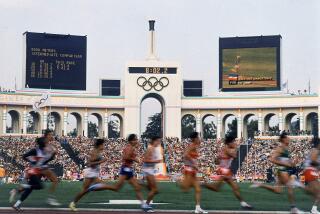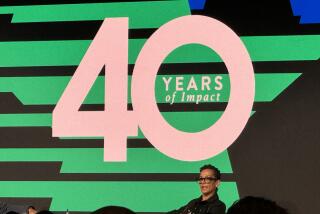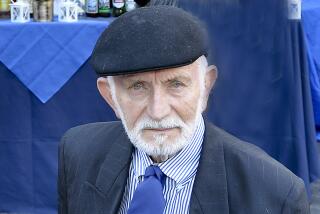Reminisces Flow When Old-timers Track Alumni Gather
Lee Evans and Tommie Smith were exchanging stories, laughs and barbs. Madeline Manning-Jackson and Jane Frederick were discussing the formation of the U.S.A. Track and Field Athletes Alumni Assn. Willye White was talking about her five Olympic teams, and John Carlos was working the room.
More than 20 Olympic gold medalists and other renowned athletes of the sport gathered last week in Sacramento for Xeroxâs Century of Champions salute on a day off from competition during the U.S. Olympic trials.
There was Wyomia Tyus in one area of the room, Al Oerter in another, Billy Mills, Valerie Brisco-Hooks, Jim Hines, Bob Hayes, Ralph Boston, Edwin Moses, Edith McGuire Duvall, Bobby Morrow, Roger Kingdom, Dick Fosbury and several others.
They were reminiscing about their glory days, or evaluating todayâs athletes, or figuring out how to improve the sportâs image, or gabbing about other matters, mostly related to track and field.
Evans, the loquacious 1968 Olympic gold medalist in the 400 meters with a world-record 43.86 seconds that stood for 20 years, and Smith, the 1968 Olympic champion in the 200 with a world-record 19.83, drew the most attention.
âThe best runner in the history of track and field was Tommie Smith,â Evans said of his former San Jose State teammate. âMichael (Johnson, the current world record-holder in the 200) is fast, but not as fast as Tommie was. Tommie is the fastest. Probably the closest is Carl (Lewis, the two-time Olympic champion in the 100).â
Evans recalled running against Smith and being dazzled by his speed.
âWhen Tommie was running fast, he made you lose control of your body,â Evans said. âIt happened to John Carlos and it happened to me. When Tommie passed me, I almost ran out of my lane. Afterward, my coach asked me why I was zig-zagging. I said, âDid you see how fast he went by me?ââ
Smith admired Evansâ hard training methods.
âTraining was very difficult for me,â Smith said. âI used to watch him and he would make me tired. I didnât like to practice.
âIf I worked like he did, my body would have blown up, but if he ran like me, he would have gotten destroyed.â
Smith recalled working in the vineyards during high school, cutting grapes from the trees.
âRunning was easier after doing that kind of labor,â he said. âOne time before a race I was told that if I took second place I would be back in the fields the next week with the other boys and girls. I won and I never had to go back.â
The two also noted the differences between the runners of their days and todayâs athletes.
âWe ran just for the glory of the sport,â Evans said. âThere was very little money then. We wanted to be the best. Itâs very different from today.â
Manning-Jackson, the 1980 Olympic gold medalist in the womenâs 800 and a four-time winner at the Olympic trials, and Fredericks, the former world record-holder in the pentathlon who missed out on the 1980 games because of the U.S. boycott, were working out a set of objectives and qualifying standards for the inaugural alumni association.
Like Smith, White, the Olympic silver medalist in the womenâs long jump as a 17-year-old in 1956 and a bronze medalist in the 400 relay in 1964, worked the fields as a youngster. She picked and chopped cotton.
She had never heard about the Olympics until 1956, when the games were in Melbourne.
âBut I heard they were being held in November,â she said, âand I knew if I could make the team I wouldnât come home until after Thanksgiving and the cotton would all be gone. I would not have to work in the cotton fields. Thatâs all I could think about.â
More to Read
Go beyond the scoreboard
Get the latest on L.A.'s teams in the daily Sports Report newsletter.
You may occasionally receive promotional content from the Los Angeles Times.







